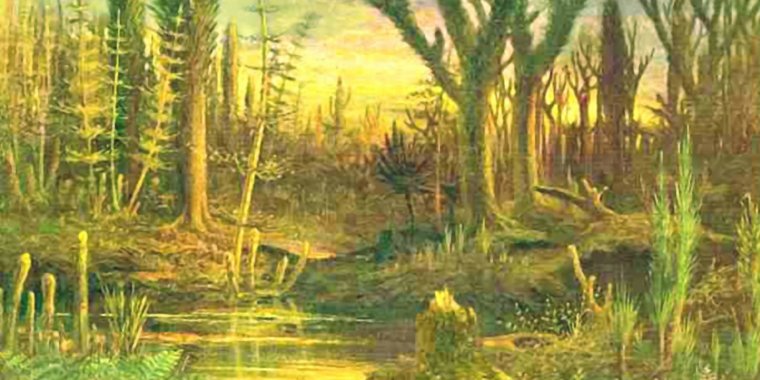| News / Science News |
Earth’s earliest forest revealed in Somerset fossils
The oldest fossilised forest known on Earth – dating from 390 million years ago – has been found in the high sandstone cliffs along the Devon and Somerset coast of South West England.

The Devonian Period marks the beginning of extensive land colonization by plants. Photo: Eduard Riou/Wikipedia
The fossils, discovered and identified by researchers from the Universities of Cambridge and Cardiff, are the oldest fossilised trees ever found in Britain, and the oldest known fossil forest on Earth.
This fossil forest is roughly four million years older than the previous record holder, which was found in New York State.
The fossils were found near Minehead, on the south bank of the Bristol Channel, near what is now a Butlin’s holiday camp. The fossilised trees, known as Calamophyton, at first glance resemble palm trees, but they were a ‘prototype’ of the kinds of trees we are familiar with today.
Rather than solid wood, their trunks were thin and hollow in the centre. They also lacked leaves, and their branches were covered in hundreds of twig-like structures.
These trees were also much shorter than their descendants: the largest were between two and four metres tall. As the trees grew, they shed their branches, dropping lots of vegetation litter, which supported invertebrates on the forest floor.
Scientists had previously assumed this stretch of the English coast did not contain significant plant fossils, but this particular fossil find, in addition to its age, also shows how early trees helped shape landscapes and stabilise riverbanks and coastlines hundreds of millions of years ago.
The forest dates to the Devonian Period, between 419 million and 358 million years ago, when life started its first big expansion onto land: by the end of the period, the first seed-bearing plants appeared and the earliest land animals, mostly arthropods, were well-established.
“The Devonian period fundamentally changed life on Earth,” said Professor Neil Davies from Cambridge’s Department of Earth Sciences, the study’s first author.
“It also changed how water and land interacted with each other, since trees and other plants helped stabilise sediment through their root systems, but little is known about the very earliest forests.”
The fossil forest identified by the researchers was found in the Hangman Sandstone Formation, along the north Devon and west Somerset coasts.
During the Devonian period, this region was not attached to the rest of England, but instead lay further south, connected to parts of Germany and Belgium, where similar Devonian fossils have been found.
The fieldwork was undertaken along the highest sea cliffs in England, some of which are only accessible by boat, and revealed that this sandstone formation is rich with plant fossil material from the Devonian period.
The researchers identified fossilised plants and plant debris, fossilised tree logs, traces of roots and sedimentary structures, preserved within the sandstone.
During the Devonian, the site was a semi-arid plain, crisscrossed by small river channels spilling out from mountains to the northwest.
“This was a pretty weird forest – not like any forest you would see today,” said Davies. “There wasn’t any undergrowth to speak of and grass hadn’t yet appeared, but there were lots of twigs dropped by these densely-packed trees, which had a big effect on the landscape.”
This period marked the first time that tightly-packed plants were able to grow on land, and the sheer abundance of debris shed by the Calamophyton trees built up within layers of sediment. The sediment affected the way that the rivers flowed across the landscape, the first time that the course of rivers could be affected in this way. (Universities of Cambridge)
YOU MAY ALSO LIKE





